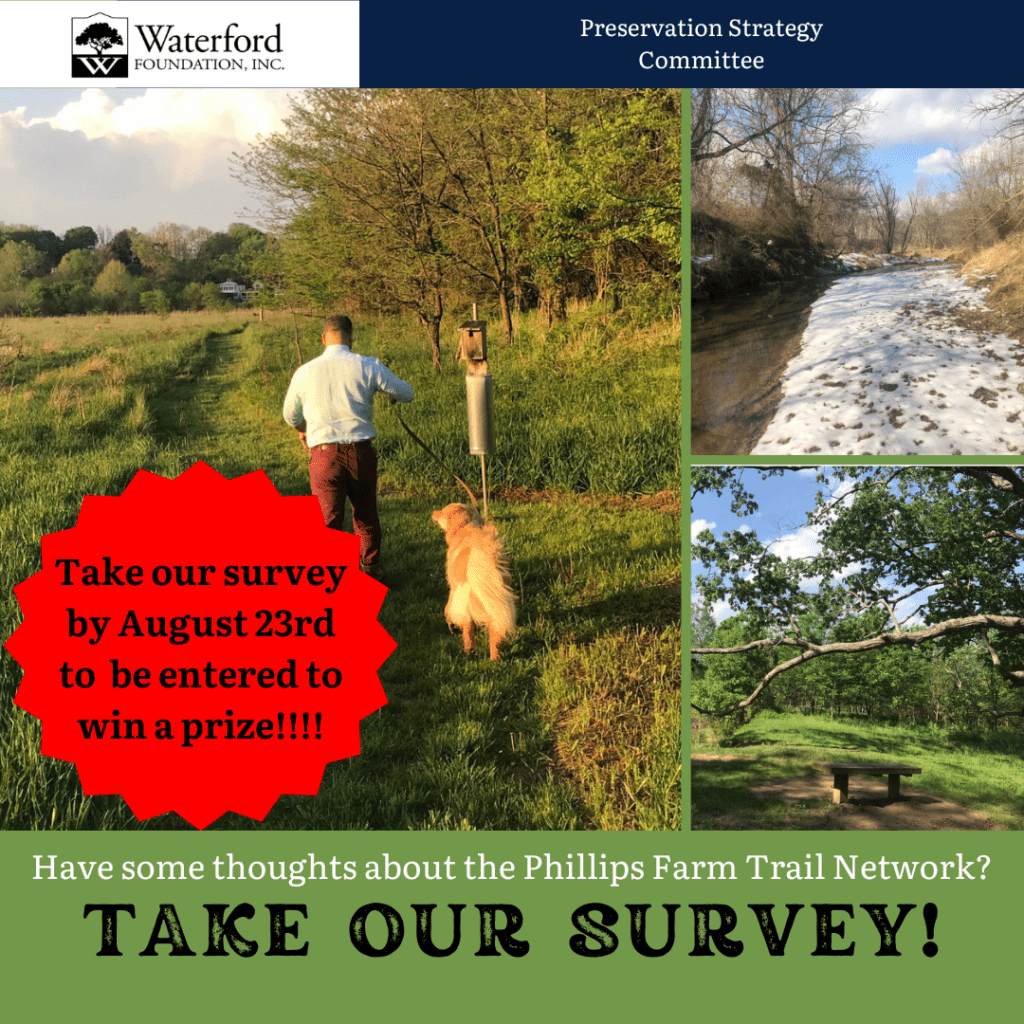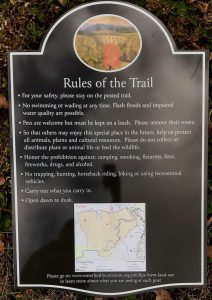Fill out our survey on the Phillips Farm Trail Network (linked here)!

The Foundation is currently looking into ways to better improve our Phillips Farm trail network and connection to other Foundation properties. To do this, we are collecting initial data on current trail usage and initial interest in the expansion of the trail network. Please take our survey to help us see current trail usage and expand on the Phillips Farm trail network! Anyone who fills out the survey prior to August 23rd gets entered to possibly win a prize!
For questions about this project, please reach out to our Historic Preservation Director at azurfluh@waterfordfoundation.org.
This page is currently under construction.

Poison Hemlock Treatment on the Phillips Farm
The Waterford Foundation’s privilege of managing the Phillips Farm, with its important natural and cultural resources, comes with challenges, including controlling invasive species. The presence of poison hemlock has been confirmed on approximately 11-acres of the Phillips Farm. This invasive plant is quite toxic, and while it has been present in the US since the 1800s, distribution of the plant has increased significantly in the past decade. The Phillips Farm Subcommittee mapped the presence of plants that were visible this spring and locations were confirmed by the Loudoun County Extension Service.
To manage this difficult invasive plant, the Waterford Foundation has retained Sustainable Solutions (sustainablesolutions.net) to initiate application of an herbicide, approved by EPA for application in and around aquatic environments to the affected areas. Treatments in 2022 made a significant impact in the distribution of the hemlock on the Farm; however, further treatment will be needed for the next several years to fully control the invasive poison hemlock.
While the Foundation has rarely used herbicides on the farm, the approved management plan for the Phillips Farm permits the use of herbicides when absolutely necessary. Out of concern for public health and for the potential for poison hemlock to continue to spread, the Foundation elected to utilize herbicide as part of an integrated approach to invasives management that will also include mowing and cutting of flower heads before they seed and promoting the establishment of native plant species.
There are other invasive species that require management, and the Waterford Foundation will employ strategies that do not require the use of herbicides whenever possible. Watch for Farm “work days” in the coming months where volunteers can assist with our work managing invasive plants
The Phillips Farm
The rolling vistas of farmland surrounding Waterford have been part of the village’s visual history for hundreds of years. Walking in the village today, you see rural field patterns that would be very familiar to villagers in the nineteenth and early twentieth centuries.
In 2003, the Phillips Farm, 144 acres of farmland southwest of the village, was slated to be subdivided into multiple lots. Had that development occurred, destroying the pastoral viewshed beyond the South Fork of the Catoctin Creek, Waterford’s National Historic Landmark status would have been seriously jeopardized.
The Waterford Foundation and its many supporters secured nearly $4 million to purchase the Phillips Farm. It is now preserved as open space in agricultural use forever, through a conservation easement held by the Virginia Outdoors Foundation. The Phillips Farm hosts Loudoun Center Apiaries and the hay fields are tended by a local farmer.
Education & Management
The opportunities on the Farm to further our understanding of this region’s agrarian past are numerous and fascinating. Protection of the site’s natural resources and agricultural use of the Farm are requirements of the conservation easement. Much of the Farm is leased to a local farmer for haymaking. Beehives on the farm managed by Loudoun Center Apiaries produce honey that can be purchased at the Foundation.
The Waterford Foundation has released a Phillips Farm Management and Land Use Plan carefully developed to ensure responsible stewardship of the Farm in accordance with the requirements of the conservation easement. (In 2010 the Virginia Department of Forestry recognized this work by designating the Farm a Certified Stewardship Forest.) Protection of the site’s natural resources and support of agricultural uses of the Farm, key requirements of the easement, are highlighted. So is its historic significance to the area. The plan also contains directions to the Farm, an Access Policy, and Rules of the Trail for visitors. A copy of the complete plan is available upon request from the Foundation office.
Educational programs for historic preservation and natural resources protection are underway on the Phillips Farm. Habitat restoration (the Farm is a Monarch Butterfly Waystation), forestry management, water quality monitoring, and riparian buffer planting are ongoing efforts coordinated by the Phillips Farm Committee. The Foundation partners with the Loudoun Wildlife Conservancy on several of these programs. Bird and butterfly counts and bluebird nest boxes provide additional educational opportunities. An interpretive trail provides visitors with an opportunity to study the history and natural beauty of the area.
Interpretive Trail

An interpretive trail goes through the Phillips Farm details the natural and cultural history on the property, with numbered posts corresponding to points of interest. This trail project was funded by a generous grant from the Peter M. Howard Memorial Fund through the Piedmont Community Foundation and the volunteer efforts of Rob Hale, John Souders, and Committee Chair Mimi Westervelt.
We welcome visitors and ask their help in preserving this special place. You may download the Phillips Farm Self-Guided Trail Walking Tour brochure here:
You may also stop in the Waterford Foundation office (T-F from 10 AM to 2 PM) to pick up a Phillips Farm Self-Guided Trail Walking Tour brochure. Follow the marked trail to learn about the history, geography, habitat restoration and monarch butterfly waystation found on site. As you hike the trail, you will understand the relationship of the Farm to the growth of the village, and why this property is so important to Waterford’s status as one of America’s National Historic Landmarks.
Western Trail Pilot Project
In 2022, a new trail on the western side of the Farm was created as a pilot project. This trail can be accessed from the interpretive pull-off on Old Wheatland Road across from Milltown Road. The same rules of the trail apply on the western trail as on the Phillips Farm Interpretive Trail on the east side of the Farm. Find a map of the new trail here:
We appreciate your feedback! Click Here to provide feedback to help us preserve and share the historic Phillips Farm!
14. White Oaklong, low branches indicate that it did not grow in a forest. Local villagers have nicknamed it “Old John” in memory of John Hough (1720-1797), a Waterford Quaker who owned thousands of acres and a number of mills in Loudoun. White oaks were favored by early settlers for building, baskets, barrels, flooring, furni-ture, and many other uses. Native Americans made flour from the acorns.
15. The Mill Dam
Consider how laborers managed to collect, move, and place such large boulders with no more than human and animal muscle. The dam once stood a few feet higher—enough to raise the level of the impoundment more than 12 feet above the outflow from the wheel at the mill. In 1908 at the near end of the dam, miller William M. Fling signed his name in wet concrete he used to cap and reinforce the dam.A bit beyond the dam, in 1814, African American Benjamin Kins and wife Letitia bought two acres spanning the creek and built a house. They were among the first black families in the area to own their own land. Benjamin had been born a slave in Calvert County, Maryland, about 1770, but owner John Talbott freed him when the Quakers abol-ished the use of slaves in 1776. Talbott Farm remains today just southeast of the village.
